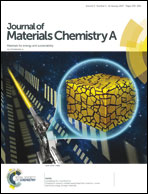Efficient molecular solar cells processed from green solvent mixtures†
Abstract
Cyclopentyl methyl ether (CPME), a green solvent, can be used to replace toxic halogenated solvents in the production of efficient molecular solar cells. With CPME alone as the processing solvent, a power conversion efficiency (PCE) of 3.13% was achieved when using a two-dimensional conjugated small molecule (SMPV1) as the donor and [6,6]-phenyl-C61-butyric acid methyl ester (PC61BM) as the acceptor to form the bulk heterojunction (BHJ) organic photovoltaic (OPV) device. This low PCE arose from the low solubility of PC61BM in this green solvent. Accordingly, toluene (Tol) was introduced in various amounts as a co-solvent for CPME. The greater solubility of PC61BM in these mixtures led to significant improvements in the short-circuit current density (Jsc) and fill factor (FF) of the device, achieving a PCE of 7% after processing in the optimized green solvent mixture of CPME : Tol (60 : 40). Furthermore, thermal annealing (TA), at 80 °C for 10 min, of the active layers processed from the 60 : 40 green solvent mixture enhanced the PCE to 8.10%—the highest ever reported for a molecular solar cell processed from a green solvent mixture. Large-area devices fabricated this way, having areas of 1 and 5.5 cm2, exhibited PCEs of 6.20 and 3.73%, respectively. The morphological changes that occurred when applying the co-solvent and TA played key roles in achieving such high PCEs for molecular solar cells processed from green solvent mixtures—a promising step toward the upscaling of OPVs.


 Please wait while we load your content...
Please wait while we load your content...